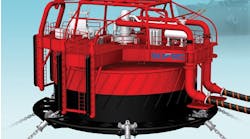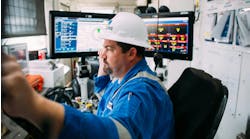Human access, egress important in early platform equipment design
Today's 3D CAD/CAM packages, together with the science of human factors engineering, allow a team of design and operating personnel to conduct a computerized "walk-through" review of a facility during the preliminary engineering phase. The review affords oil and gas operating companies improved accuracy and insight into the design process, while facilitating a rapid progression from concept to construction without the need to develop scaled models.
Human factors engineering (HFE) and the effective application of a dynamic 3D modeling system enhance the design process with improved quality and project efficiency in terms of schedule and equipment costs. The integration of HFE into the design analysis provides an additional perspective to potentially minimize rework and modifications during fabrication and construction.
Early involvement of HFE specialists also helps to evaluate the future operability and maintainability of a facility against the immediate engineering and financial constraints involved in defining and implementing a field development plan. Human factors or ergonomics represents the study of people in terms of behavior and physical characteristics. HFE integrates the knowledge of human abilities and limitations with product, workplace and facility design to improve the efficient, safe and healthy functioning of people. HFE has its origins in the defense, transportation, and space industries.
Statistics published by the Minerals Management Service (MMS) and the Health and Safety Executive in the UK have heightened HFE's importance to the offshore industry. The MMS categorizes a large number of offshore incidents and fatalities as "human error" and as "slips, trips, and falls." Similarly, the UK HSE has found that the most common accidents suffered by offshore personnel involve slips, trips, falls and handling of goods and materials. These developments, and the needs of offshore customers, encouraged Paragon Engineering Services to form a team of professionals focused on HFE issues and solutions.
Application in design
Shell, which is involved in HFE applications and 3D CAD (computer-aided design) PDMS (plant design management system), first integrated human and organizational factors activities into its Gulf of Mexico deepwater developments in 1990. As deepwater facilities become bigger, more complex and require larger staff commitments to operate and maintain systems and equipment, the potential for losses from personnel injuries, fatalities, and property damage is increased. As a result, Shell has looked for ways to control losses and reduce human error by incorporating HFE into design.
Beginning with the Auger tension leg platform, Shell identified opportunities for increased safety awareness and improved HFE engineering design. Shell continued to maximize HFE on the Mars TLP and with subsequent platforms, including Ram-Powell and Ursa. HFE specialists from Paragon provided Shell with HFE support on several frontier projects, including the Brutus TLP.
Input for human factors engineering takes place throughout the design process, impacting product, equipment, and facility designs, and is critical in the conceptual and early development stages of design. The benefits of applying HFE to the design include improvements in:
- Human performance and system availability
- Safety and fewer losses from accidents and misuse
- Training costs, manpower utilization, and user acceptance
Basic HFE design criteria, such as reach distances, access/egress, fit, vision and posture, must be satisfied very early in the design process because modifications later in the project can have financial and time penalties. The effective use of computer 3D graphics and "human modeling" during the traditional drawing review or mock-up stage helps ensure that the finished product meets HFE requirements.
3D human modeling
The involvement of end user operations and maintenance personnel during the 3D human modeling review is critical to the process. Input from end users helps define task requirements and provide valuable insight into the design process. Other participants include a skilled CAD operator, the design or lead engineer responsible for the equipment being reviewed, and an HFE specialist. The following HFE issues can be reviewed dimensionally or from different perspectives, depending on the level of modeling detail available at that stage of the design process:
- Operability: Appropriate placement and orientation of all controls and displays/ instruments to ensure safe and effective viewing, reach and operation by the user population.
- Maintainability: Efficient and safe removal of equipment requiring maintenance without hazardous removal of other items such as piping, motors, and other devices.
- Access/egress: Safe access and evacuation of all areas of the facility/plant and equipment under normal or adverse weather and emergency conditions. Other issues in this area include: adequate space around equipment; appropriate facilities for working at heights; availability of site preparation and lay down areas; availability of permanent work surfaces at locations requiring operators or maintainers to produce manual forces (torque, pushing or pulling); and awareness of size, shape, location, and weight of access hatches, covers and doors.
- Manual materials handling: Requirements for manual lifting, pulling, pushing, and carrying of equipment, with respect for the biomechanical and physiological capabilities and limitations of the user population. Associated needs include the availability of mechanical lifting aids for assisted lifting and appropriate storage or placement of lifting aids for safe reach and effective operation.
- Communication and labeling: Clear communication of information and equipment identification, including effective viewing, reading and understanding of instructions, signs, and labels.
- Lighting: Adequate lighting for effective and safe operation and maintenance of the plant or facility and equipment.
Project efficiency
Three-dimensional modeling enables HFE experts to share the same data base with engineering and construction teams, building efficiency into the design process and the entire project. Previously, drawings were provided in a specific format for HF review purposes.
Shell uses 3D modeling as a tool to visually demonstrate the impact of HFE requirements and improvements, compared with written specifications and guidelines. Effective application of 3D human modeling also allows designers to standardize and re-use good designs. Because the original design is approved, only cursory checks for quality control are needed.
Three-dimensional human modeling CAD systems that incorporate an anthropometric (human body dimensions) data base and detailed task requirements allow designers to more accurately predict HFE issues, including reach, fit, access/egress, and vision. The variable anthropometric data allow a design scheme to become "culturally calibrated" for different users or ethnic populations. The 3D modeling approach further identifies potential problems that may be overlooked in the traditional 2D drawing evaluation.
No average users
The CAD operator and HF reviewer have complete control of setting the dimensions or percentile values of the human model. However, the CAD operator or HFE reviewer needs a clear understanding of anthropometric data and their application during design. Accurate assessment of the consequences in terms of human performance and safety is dependent upon this data.
A common mistake in the design phase is assuming that a person's physical body dimensions are all "average" when an individual is of average height. HFE specialists know that the "average" person concept is a fallacy. For example, a researcher conducting an anthropometric survey showed that no one in a sample of 4,000 flying personnel was loosely "average" in all 10 of the body dimensions examined. The HFE reviewer incorporates this theory into the process and applies techniques to ensure that human models are statistically correct.
Realistic 3D "human modeling" facilitates many improvements in the design and final use of simple and complex human-machine interface technology. Design teams, however, must remember that human models are not the end-users of the design and that operators and maintainers are unlikely to be as obliging as the "static" 3D model. As a result, careful consideration of end use is critical to safe and efficient operations.


